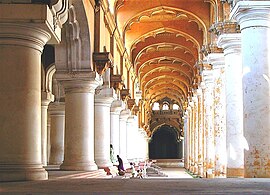Meenakshi (Nayak queen)
| Kings and Queen Regents of Madurai Nayak Dynasty |
|
|---|---|
| Part of History of Tamil Nadu | |
 |
|
| Madurai Nayak rulers | |
| Viswanatha Nayak | 1529–1563 |
| Kumara Krishnappa Nayak | 1563–1573 |
| Joint Rulers Group I | 1573–1595 |
| Joint Rulers Group II | 1595–1602 |
| Muttu Krishnappa Nayak | 1602–1609 |
| Muttu Virappa Nayak | 1609–1623 |
| Tirumalai Nayak | 1623–1659 |
| Muthu Alakadri Nayak | 1659–1662 |
| Chokkanatha Nayak | 1662–1682 |
| Rangakrishna Muthu Virappa Nayak | 1682–1689 |
| Rani Mangammal‡ | 1689–1704 |
| Vijaya Ranga Chokkanatha Nayak | 1704–1731 |
| Queen Meenakshi‡ | 1731–1736 |
| ‡ Regent Queens | |
| Capitals | |
| Madurai | 1529–1616 |
| Tiruchirapalli | 1616–1634 |
| Madurai | 1634–1665 |
| Tiruchirapalli | 1665–1736 |
| Major forts | |
| Madurai 72 Bastion Fort | |
| Tiruchirapalli Rock Fort | |
| Dindigul Fort | |
| Thirunelvelli Fort | |
| other Military forts | |
| Namakkal Fort | |
| Sankagiri Fort | |
| Attur Fort | |
| Palaces | |
| Thirumalai Nayak Mahal, Madurai | |
| Chokkanatha Nayak Palace a.k.a. Durbar Hall, Tiruchirapalli | |
| Rani Mangammal Tamukkam palace Madurai | |
Meenakshi (ruled 1731–1736) was the last ruler in the Madurai Nayaks line. She was the granddaughter-in-law of Rani Mangammal.
Vijaya Ranga Chokkanatha died in 1731, and was succeeded by his widow Meenakshi, who acted as Queen-Regent on behalf of a young boy she had adopted as the heir of her dead husband. She had only ruled a year or two when an insurrection was raised against her by Vangaru Tirumala, the father of her adopted son, who pretended to have claims of his own to the throne of Madurai. At this juncture representatives of the Mughals appeared on the scene and took an important part in the struggle.
Since 1693, Madurai nominally had been the feudatory of the Mughal Emperor Aurangzeb, and since 1698 the Carnatic region north of the Coleroon (Kollidam) river had been under direct Mughal rule. The local representative of the Mughal Emperor Muhammad Shah were the Nawab of Arcot, and an intermediate authority was held by the Nizam of Hyderabad, who was in theory both a subordinate of the Mughal Emperors, and the superior of the Nawab.
How regularly the kings of Tanjore and Madura paid their tribute is not clear, but in 1734 — about the time, in fact, that Meenakshi and Vangaru Thirumala were fighting for the crown — an expedition was sent by the then-Nawab of Arcot to exact tribute and submission from the kingdoms of the south. The leaders of this expedition were the Nawab’s son, Safdar Ali Khan, and his nephew and confidential adviser, the well-known Chanda Sahib.
The expedition team took Tanjore by storm and, leaving the stronghold of Trichinopoly untouched, swept across Madurai and Tinnevelly and into Travancore. On their return from this expedition they took part in the quarrel between Meenakshi and Vangaru Tirumala. The latter approached Safdar Ali Khan with an offer of three million rupees if he would oust the queen in favour of himself. Unwilling to attack Trichinopoly, the Arcot prince contented himself with solemnly declaring Vangaru Thirumala to be king and taking the bond for the three millions. He then marched away, leaving Chanda Sahib to enforce his award as best he could. The queen, alarmed at the turn affairs now had taken, had little difficulty in persuading that facile politician to accept her bond for a crore of rupees (ten million) and declare her duly entitled to the throne.
...
Wikipedia
